Patterns of Social, Emotional, and Behavioral Development (0-19 years)
VerifiedAdded on 2023/01/16
|5
|751
|56
Essay
AI Summary
This essay provides an overview of social, emotional, and behavioral development, focusing on the age range of 0-19 years. It outlines expected patterns at different stages, from infancy to adolescence, covering key milestones and changes. The essay includes a discussion of Freud's psychoanalytic theory, explaining how the id, ego, and superego influence behavior and personality development. It further explores the five stages of development according to Freud, including the oral, anal, phallic, latency, and genital stages, highlighting their significance in shaping an individual's emotional and social understanding. The conclusion emphasizes the importance of social, emotional, and behavioral development for overall child development, noting that it occurs through distinct patterns across different ages.
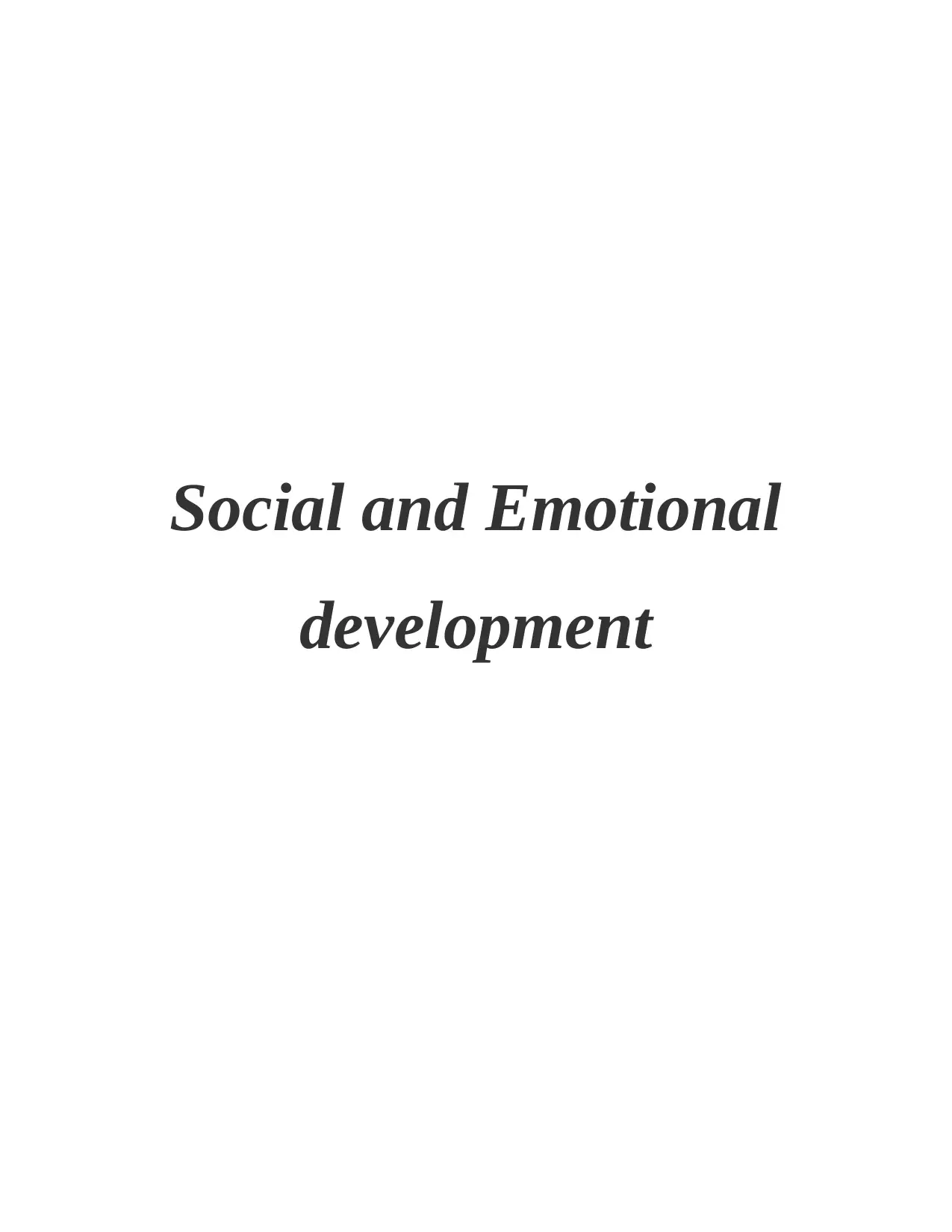
Social and Emotional
development
development
Paraphrase This Document
Need a fresh take? Get an instant paraphrase of this document with our AI Paraphraser
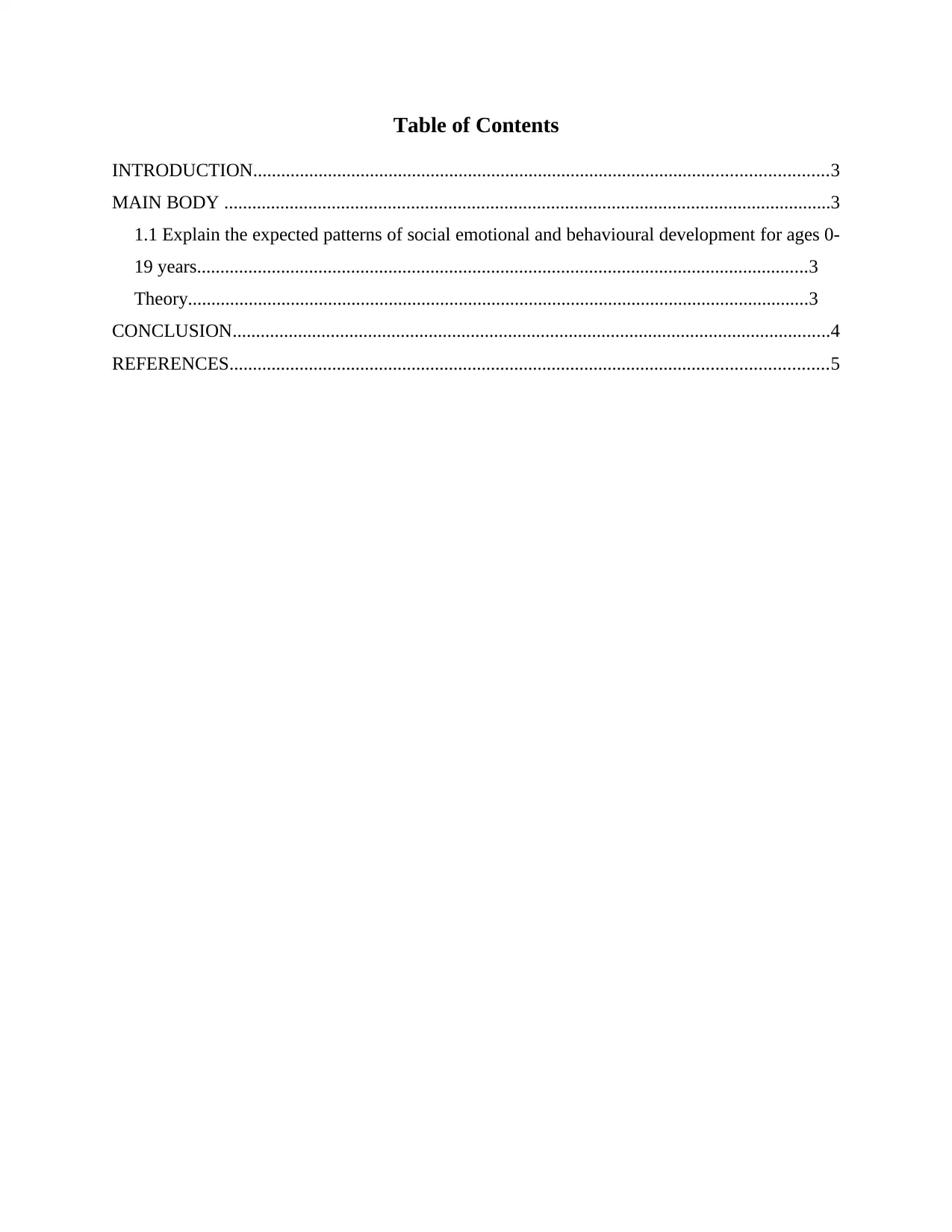
Table of Contents
INTRODUCTION...........................................................................................................................3
MAIN BODY ..................................................................................................................................3
1.1 Explain the expected patterns of social emotional and behavioural development for ages 0-
19 years...................................................................................................................................3
Theory.....................................................................................................................................3
CONCLUSION................................................................................................................................4
REFERENCES................................................................................................................................5
INTRODUCTION...........................................................................................................................3
MAIN BODY ..................................................................................................................................3
1.1 Explain the expected patterns of social emotional and behavioural development for ages 0-
19 years...................................................................................................................................3
Theory.....................................................................................................................................3
CONCLUSION................................................................................................................................4
REFERENCES................................................................................................................................5
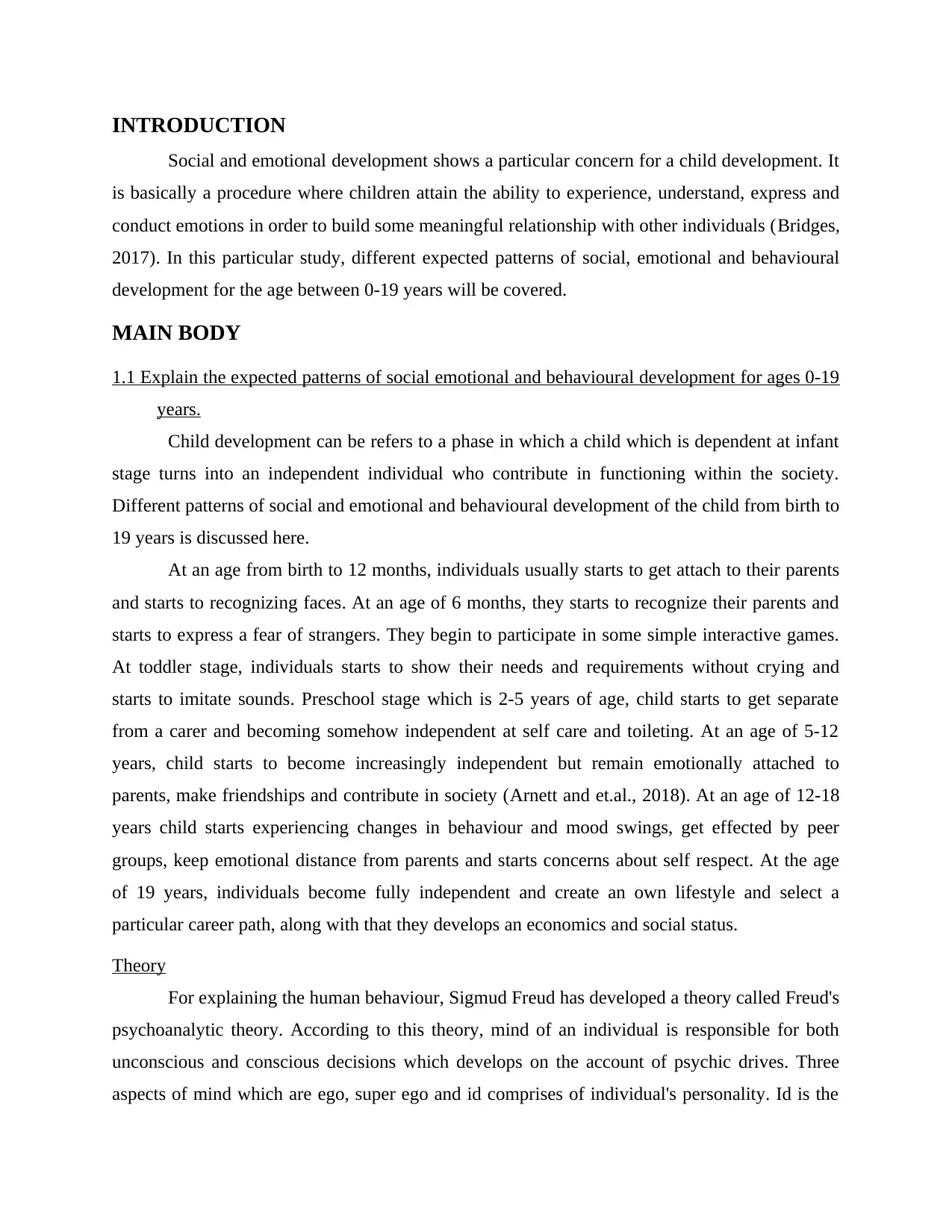
INTRODUCTION
Social and emotional development shows a particular concern for a child development. It
is basically a procedure where children attain the ability to experience, understand, express and
conduct emotions in order to build some meaningful relationship with other individuals (Bridges,
2017). In this particular study, different expected patterns of social, emotional and behavioural
development for the age between 0-19 years will be covered.
MAIN BODY
1.1 Explain the expected patterns of social emotional and behavioural development for ages 0-19
years.
Child development can be refers to a phase in which a child which is dependent at infant
stage turns into an independent individual who contribute in functioning within the society.
Different patterns of social and emotional and behavioural development of the child from birth to
19 years is discussed here.
At an age from birth to 12 months, individuals usually starts to get attach to their parents
and starts to recognizing faces. At an age of 6 months, they starts to recognize their parents and
starts to express a fear of strangers. They begin to participate in some simple interactive games.
At toddler stage, individuals starts to show their needs and requirements without crying and
starts to imitate sounds. Preschool stage which is 2-5 years of age, child starts to get separate
from a carer and becoming somehow independent at self care and toileting. At an age of 5-12
years, child starts to become increasingly independent but remain emotionally attached to
parents, make friendships and contribute in society (Arnett and et.al., 2018). At an age of 12-18
years child starts experiencing changes in behaviour and mood swings, get effected by peer
groups, keep emotional distance from parents and starts concerns about self respect. At the age
of 19 years, individuals become fully independent and create an own lifestyle and select a
particular career path, along with that they develops an economics and social status.
Theory
For explaining the human behaviour, Sigmud Freud has developed a theory called Freud's
psychoanalytic theory. According to this theory, mind of an individual is responsible for both
unconscious and conscious decisions which develops on the account of psychic drives. Three
aspects of mind which are ego, super ego and id comprises of individual's personality. Id is the
Social and emotional development shows a particular concern for a child development. It
is basically a procedure where children attain the ability to experience, understand, express and
conduct emotions in order to build some meaningful relationship with other individuals (Bridges,
2017). In this particular study, different expected patterns of social, emotional and behavioural
development for the age between 0-19 years will be covered.
MAIN BODY
1.1 Explain the expected patterns of social emotional and behavioural development for ages 0-19
years.
Child development can be refers to a phase in which a child which is dependent at infant
stage turns into an independent individual who contribute in functioning within the society.
Different patterns of social and emotional and behavioural development of the child from birth to
19 years is discussed here.
At an age from birth to 12 months, individuals usually starts to get attach to their parents
and starts to recognizing faces. At an age of 6 months, they starts to recognize their parents and
starts to express a fear of strangers. They begin to participate in some simple interactive games.
At toddler stage, individuals starts to show their needs and requirements without crying and
starts to imitate sounds. Preschool stage which is 2-5 years of age, child starts to get separate
from a carer and becoming somehow independent at self care and toileting. At an age of 5-12
years, child starts to become increasingly independent but remain emotionally attached to
parents, make friendships and contribute in society (Arnett and et.al., 2018). At an age of 12-18
years child starts experiencing changes in behaviour and mood swings, get effected by peer
groups, keep emotional distance from parents and starts concerns about self respect. At the age
of 19 years, individuals become fully independent and create an own lifestyle and select a
particular career path, along with that they develops an economics and social status.
Theory
For explaining the human behaviour, Sigmud Freud has developed a theory called Freud's
psychoanalytic theory. According to this theory, mind of an individual is responsible for both
unconscious and conscious decisions which develops on the account of psychic drives. Three
aspects of mind which are ego, super ego and id comprises of individual's personality. Id is the
⊘ This is a preview!⊘
Do you want full access?
Subscribe today to unlock all pages.

Trusted by 1+ million students worldwide
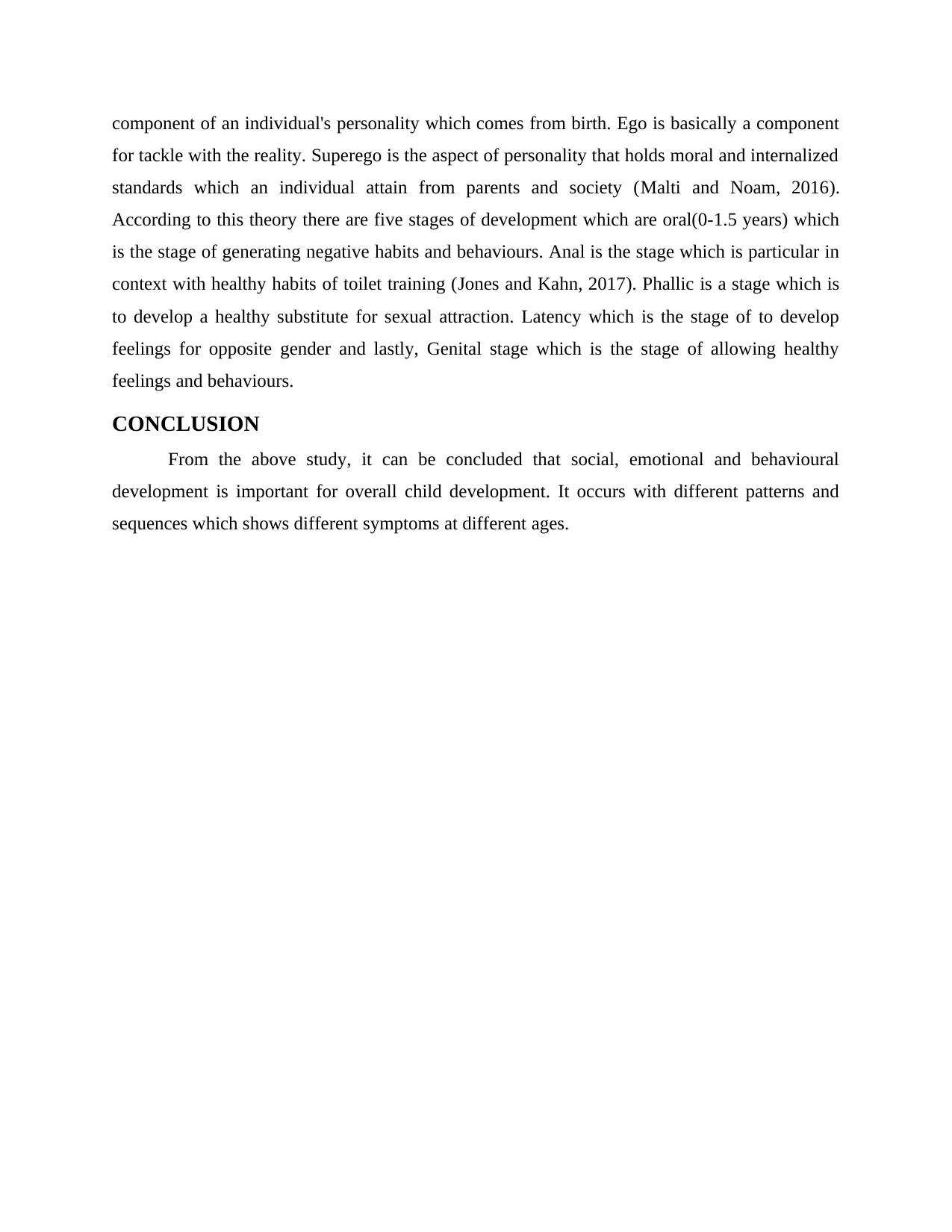
component of an individual's personality which comes from birth. Ego is basically a component
for tackle with the reality. Superego is the aspect of personality that holds moral and internalized
standards which an individual attain from parents and society (Malti and Noam, 2016).
According to this theory there are five stages of development which are oral(0-1.5 years) which
is the stage of generating negative habits and behaviours. Anal is the stage which is particular in
context with healthy habits of toilet training (Jones and Kahn, 2017). Phallic is a stage which is
to develop a healthy substitute for sexual attraction. Latency which is the stage of to develop
feelings for opposite gender and lastly, Genital stage which is the stage of allowing healthy
feelings and behaviours.
CONCLUSION
From the above study, it can be concluded that social, emotional and behavioural
development is important for overall child development. It occurs with different patterns and
sequences which shows different symptoms at different ages.
for tackle with the reality. Superego is the aspect of personality that holds moral and internalized
standards which an individual attain from parents and society (Malti and Noam, 2016).
According to this theory there are five stages of development which are oral(0-1.5 years) which
is the stage of generating negative habits and behaviours. Anal is the stage which is particular in
context with healthy habits of toilet training (Jones and Kahn, 2017). Phallic is a stage which is
to develop a healthy substitute for sexual attraction. Latency which is the stage of to develop
feelings for opposite gender and lastly, Genital stage which is the stage of allowing healthy
feelings and behaviours.
CONCLUSION
From the above study, it can be concluded that social, emotional and behavioural
development is important for overall child development. It occurs with different patterns and
sequences which shows different symptoms at different ages.
Paraphrase This Document
Need a fresh take? Get an instant paraphrase of this document with our AI Paraphraser
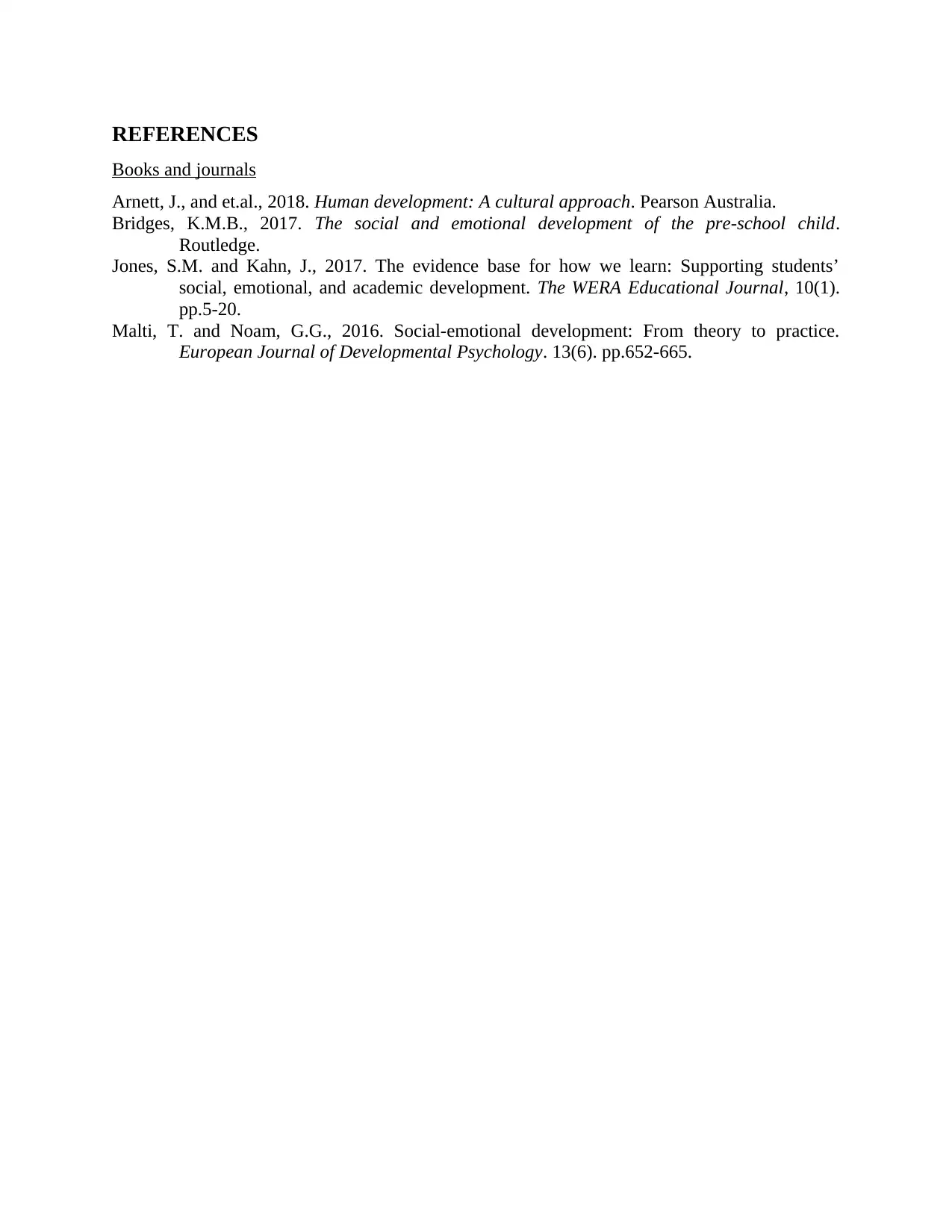
REFERENCES
Books and journals
Arnett, J., and et.al., 2018. Human development: A cultural approach. Pearson Australia.
Bridges, K.M.B., 2017. The social and emotional development of the pre-school child.
Routledge.
Jones, S.M. and Kahn, J., 2017. The evidence base for how we learn: Supporting students’
social, emotional, and academic development. The WERA Educational Journal, 10(1).
pp.5-20.
Malti, T. and Noam, G.G., 2016. Social-emotional development: From theory to practice.
European Journal of Developmental Psychology. 13(6). pp.652-665.
Books and journals
Arnett, J., and et.al., 2018. Human development: A cultural approach. Pearson Australia.
Bridges, K.M.B., 2017. The social and emotional development of the pre-school child.
Routledge.
Jones, S.M. and Kahn, J., 2017. The evidence base for how we learn: Supporting students’
social, emotional, and academic development. The WERA Educational Journal, 10(1).
pp.5-20.
Malti, T. and Noam, G.G., 2016. Social-emotional development: From theory to practice.
European Journal of Developmental Psychology. 13(6). pp.652-665.
1 out of 5
Related Documents
Your All-in-One AI-Powered Toolkit for Academic Success.
+13062052269
info@desklib.com
Available 24*7 on WhatsApp / Email
![[object Object]](/_next/static/media/star-bottom.7253800d.svg)
Unlock your academic potential
Copyright © 2020–2025 A2Z Services. All Rights Reserved. Developed and managed by ZUCOL.





